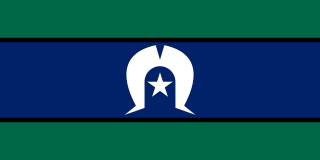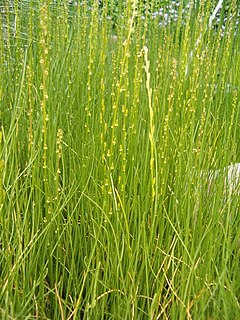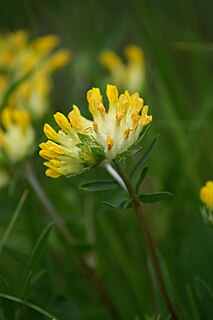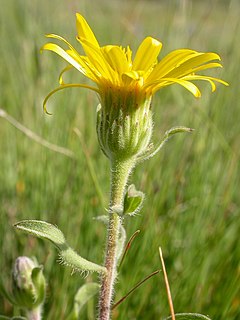
Sorghum is a genus of about 25 species of flowering plants in the grass family (Poaceae). Some of these species are grown as cereals for human consumption and some in pastures for animals. One species, Sorghum bicolor, was originally domesticated in Africa and has since spread throughout the globe. Seventeen of the 25 species are native to Australia, with the range of some extending to Africa, Asia, Mesoamerica, and certain islands in the Indian and Pacific Oceans. One species is grown for grain, while many others are used as fodder plants, either cultivated in warm climates worldwide or naturalized in pasture lands. Sorghum is in the subfamily Panicoideae and the tribe Andropogoneae.

Prosopis is a genus of flowering plants in the family Fabaceae. It contains around 45 species of spiny trees and shrubs found in subtropical and tropical regions of the Americas, Africa, Western Asia, and South Asia. They often thrive in arid soil and are resistant to drought, on occasion developing extremely deep root systems. Their wood is usually hard, dense and durable. Their fruits are pods and may contain large amounts of sugar. The generic name means "burdock" in late Latin and originated in the Greek language.

The Torres Strait Islands are a group of at least 274 small islands in the Torres Strait, a waterway separating far northern continental Australia's Cape York Peninsula and the island of New Guinea. They span an area of 48,000 km2 (19,000 sq mi), but their total land area is 566 km2 (219 sq mi).

The Gnaphalieae are a tribe of flowering plants in the family Asteraceae. It is most closely related to the tribes Anthemideae, Astereae, and Calenduleae.

Triglochin is a plant genus in the family Juncaginaceae described by Carl Linnaeus in 1753. It is very nearly cosmopolitan in distribution, with species on every continent except Antarctica. North America has four accepted species, two of which can also be found in Europe: Triglochin palustris and Triglochin maritima. Australia has many more.
Hermann August Theodor Harms was a German taxonomist and botanist.

Anthyllis is a genus of flowering plants in the family Fabaceae. This genus contains both herbaceous and shrubby species and is distributed in Europe, the Middle East and North Africa. The most widespread and familiar species is A. vulneraria, a familiar grassland flower which has also been introduced to New Zealand.

Missulena is a genus of mygalomorph spiders in the family Actinopodidae. It was first described by Charles Walckenaer in 1805, and it's a senior synonym of Eriodon. M. tussulena is found in Chile, but the rest are indigenous to Australia.

Asteromyrtus is a genus of flowering plants in the Myrtaceae family. It is closely related to Callistemon and Melaleuca.

Lepturus is a genus of plants in the grass family, native to Asia, Africa, Australia, and various islands in the Indian and Pacific Oceans.
Spirotecoma is a genus of plants in the family Bignoniaceae.
Ferruccio Dalla Torre was an Italian bobsledder who competed from the late 1950s to the mid-1960s. He won three medals in the four-man event at the FIBT World Championships with one gold (1963) and two silvers.
Karl Wilhelm von Dalla Torre was an Austrian taxonomist, entomologist and botanist.

Antonio Esposito is an Italian singer, songwriter and musician.
Nesodynerus is a genus of potter wasps endemic to the Hawaiian archipielago. This genus is surprisingly large for the small territory it covers. The genera Chelodynerus and Pseudopterocheilus are presently treated as synonyms of Nesodynerus.

Fra' Giacomo dalla Torre del Tempio di Sanguinetto was the Prince and 80th Grand Master of the Sovereign Military Order of Malta. Born in Rome to a noble family with extensive ties to the Vatican, he completed his studies at the Sapienza University of Rome and taught at the Pontifical Urban University. He joined the Order in 1985 and took full vows in 1993 to become a Knight of Justice. Dalla Torre served two separate stints as interim leader of the Order, from February to March 2008 and again from 2017 until 2018. He was elected Grand Master of the Order on 2 May 2018 and served until his death. During his time in office, he endeavoured to repair the Order's relations with the Vatican, which had been strained since Pope Francis ordered his predecessor to resign.

Willemetia is a genus of flowering plants in the daisy family. It is native to Europe, Iran and the Caucasus.

Heterotheca villosa, called the hairy goldenaster, is a North American species of flowering plant in the aster family. It widespread across the central and western parts of the continent, from Ontario west to British Columbia and south as far as Illinois, Kansas, Nuevo León, Guanajuato, and northern Baja California.

Dasymaschalon is an Asian genus of bushy plants in the subfamily Annonoideae and tribe Uvarieae. Its native range is from southern China, Indo-China to Malesia.
Plutarchia is a genus of chalcid wasp in the subfamily Eurytominae. Alexandre Arsène Girault first circumscribed the genus in 1925; its name honors Plutarch. The genus initially only comprised its type species, P. bicarinativentris, found in Australia. Subsequent species from South Asia and Nigeria have been described and transferred to Plutarchia.













